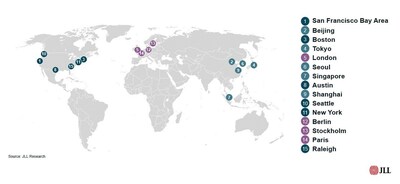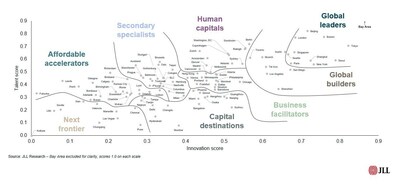Throughout the next decade, market specialization, talent migration, sustainability goals and new technologies such as AI will continue to shape the global knowledge economy and high-tech industry ecosystem. The third edition of JLL’s Innovation Geographies examines how innovation continues to influence real estate location and portfolio strategies, based on the dynamics of 108 cities globally. Ranked across a range of output, funding and talent indicators, JLL identified eight groups of cities across varying innovation and talent concentrations to provide a perspective into rapidly evolving global, regional and national landscapes.
Capital injection into new technologies, such as generative AI, has fueled market expansion
As emerging and alternative technologies continue to drive innovation, the San Francisco Bay Area remains the top city globally for both innovation and talent by a significant margin, outperforming most on venture capital, research and development investment, productivity and talent breadth. This is evident through investments in new technologies, such as generative AI, of which the Bay Area received nearly $49 billion in funding over the past three years – more than Beijing and New York combined. Beijing, Boston, Tokyo, London, Seoul, Singapore, Shanghai, New York and Paris also continue to be top performing hubs for innovation and talent, as was the case in previous years.
However, as talent shortages, rising home prices and regulatory pressures catalyze expansion into lower-cost markets, cities such as Austin have joined the ranks of global innovation hubs and secondary markets are improving their breadth of talent and scale of output. Similarly, mid-sized cities including Brisbane, Lisbon, Manchester, Raleigh, North Carolina and China’s Hangzhou have also experienced both innovation and talent improvements.
“As opportunities for innovation continue to grow globally, corporations and investors must navigate a landscape where mature and emerging hubs complement each other,” said Phil Ryan, Research Director at JLL. “Finding the right balance of assets across established markets and emerging secondary and tertiary markets globally will be crucial for sustained growth and resilience, especially as emerging markets become more competitive.”
Trade and the urban form are also impacting the geography of innovation
External geopolitical forces are shaping the geography of innovation with more aggressive trade and industrial policies in the U.S., the EU and China incentivizing onshoring and domestic production of critical components. This realignment will place additional emphasis on in-house research and development, as well as co-location with manufacturing firms’ access to transportation and logistics nodes. Phoenix, Columbus, Berlin and Fukuoka, Japan are just some of the cities with multi-billion-dollar semiconductor or high-tech materials fabrication plants being built in or near their metropolitan areas due to these policies.
Sustainability and efficiency standards also continue to drive innovation, as many of the fastest-growing innovation hubs, particularly those in Asia and the United States, are at the highest risk of the effects of climate change. Advancement in green prop-tech will be crucial in helping to lower emissions in existing buildings, which represent more than 80% of future inventory in 2050. Innovation anchors are and will continue to be vital to the success of accommodating this growth in precincts such as Tech Central in Sydney, the Jurong Innovation District in Singapore, Schuylkill Yards in Philadelphia and ID in Manchester, which exemplify the ability of innovation to catalyze multi-faceted regeneration.
Find out more by downloading the Innovation Geographies whitepaper here.





















